 |
|
Here and There introduces art, artists, galleries and museums around Japan that non-Japanese readers and first-time visitors may find of particular interest. The writer claims no art expertise, just a subjective viewpoint acquired over many years' residence in Japan.
|
|
 |
|
|
 |
 |
No Accounting for Taste: The Takahashi Collection at Opera City
Alan Gleason |
 |
|
Erina Matsui, Food Chain Star Wars! (2008), © Erina Matsui, courtesy of Yamamoto Gendai. |
Tokyo-based psychiatrist Ryutaro Takahashi is known at home and abroad for the singular collection of contemporary Japanese art he has amassed over the past couple of decades. Every few years a selection of his holdings makes an appearance at some local museum, but the show now at Tokyo Opera City Art Gallery was my first opportunity to see the legendary Takahashi Collection for myself. In terms of scale and thoroughness (52 artists and 140 works out of the 2,000 plus in Takahashi's possession) it did not disappoint, even if some of the art did.
Titled Mirror Neuron at the suggestion of the doctor himself, the show is a sort of Contemporary Japanese Art 101, taking the viewer on a tour that is remarkably comprehensive, considering it reflects the tastes of one individual. Though Takahashi's favorites are obvious -- several rooms are occupied by single artists -- they run the gamut of sensibilities. It's hard to discern any particular pattern in the collector's acquisitional impulses. But whatever his criteria, he certainly has an eye for star quality.
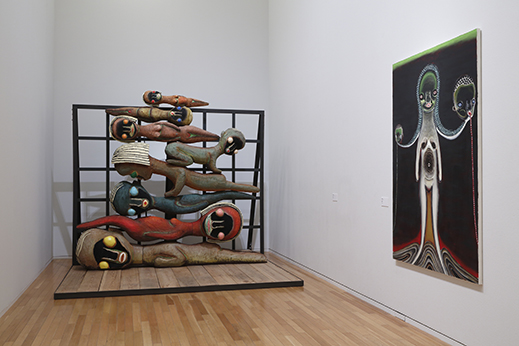 |
|
Izumi Kato, Untitled (2010), sculpture, and Untitled (2007), painting; © Izumi Kato,
courtesy of the artist and Galerie Perrotin. Photo by Keizo Kioku |
Takahashi has been collecting since the 1990s, and his bio suggests that he has been a fan of contemporary Japanese art since coming across footage of Yayoi Kusama's New York happenings while a college student. One of his first "discoveries" as a collector was Makoto Aida, whose work he began snapping up well before Aida became one of Japan's reigning enfants terribles. He showed a similar enthusiasm early on for Yoshitomo Nara and Takashi Murakami, now practically household names. All are strong artists with unmistakable identities; love 'em or hate 'em, their work is not easily ignored.
|
The Yayoi Kusama room at the Mirror Neuron show. At center right is Infinity Mirrored Room - Love Forever (No. 3) (1964-86) and at far right is Pumpkin (1990). All works © Yayoi Kusama;
courtesy of Kusama Enterprise, Ota Fine Arts. Photo by Keizo Kioku |
The exhibition is laid out in roughly chronological order. Starting things off, fittingly, is Kusama, the grand doyenne of the Japanese avant-garde, alive and still kicking at 86. She gets an entire room to herself, and there are some fine pieces here, notably her giant polka-dotted yellow Pumpkin and a large box-shaped object covered in soft, silvery, phallic protuberances. Look inside the box through the little window and you see a field of candy-striped nubs extending off into mirrored infinity. Above them hangs a mirror from which you stare back at yourself. Titled Infinity Mirrored Room - Love Forever, could it be Kusama's puckish point that each of us is our own ultimate love object?
Next up is a room inhabited by Yoshitomo Nara's paintings of evil-eyed little girls. An acquired taste that has always escaped me, Nara's work somehow achieves critical mass here, and for the first time I found myself reading complex emotions into those eerily affectless faces. Perhaps one factor is the contrast he supplies with painted backgrounds that add some artistic heft to his rather wispy-looking waifs.
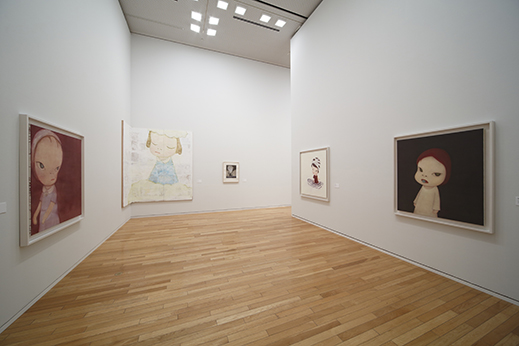 |
|
The Yoshitomo Nara room. All works © Yoshitomo Nara; courtesy of the artist. Photo by Keizo Kioku |
Where Nara is found, Takashi Murakami is rarely far behind. Japanese art's bad boy, who has taken manga/anime motifs to a kitsch outland where even Jeff Koons fears to tread, fills the gallery adjacent to Nara's with motifs so gleefully cartoony that they positively ooze nihilism. Yet here, too, one can find works with some sort of depth -- notably a triptych that has platoons of tiny American soldiers glued to boards painted in interesting textures that, like Nara's, help anchor the figures in the foreground.
|
A room featuring several "elder statesmen" of the contemporary art scene.
From left: Kishio Suga, Supplemented Material (1986), © Kishio Suga, courtesy of Tomio Koyama Gallery; Koji Enokura, Drawing B - No. 19 (1981), © Koji Enokura; Lee Ufan, Correspondance (2002), © Lee Ufan; Yuichi Inoue, Wind (1968), © UNAC Tokyo. Photo by Keizo Kioku |
After getting one's psyche smacked around by these current critical darlings, it was a relief to move on to a room devoted to avant-gardists who came of age slightly earlier, in the 1950s and 1960s. According to the exhibition material, Takahashi has broadened his horizons in recent years to embrace movements like Mono-ha, represented here by such veterans as Kishio Suga. These older artists clearly address concerns that truly matter to them, whether compositional or social, and put some effort into giving them form. Among the most innovative works in the entire show are those by Koji Enokura, Yuichi Inoue and Kenzo Okada, who are no longer with us, and Suga and Nobuo Sekine, in their seventies but still active.
|
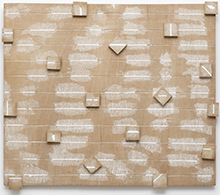 |
|
|
|
Close-up view of Kishio Suga, Supplemented Material (1986), © Kishio Suga. Photo by Keizo Kioku |
In the next gallery the exhibition fast-forwards to the millennium, where it skips around sampling from more recently emerged talents. Makoto Aida gets his own room, with a number of monumental works that manage to be at once profound and horrific -- a wall-size painting of a gaggle of schoolgirls being crushed and dismembered in a gargantuan blender is typical. Further indulging the millennial penchant for Freudian grotesqueries are Yasuyuki Nishio, whose massive sculpture of a female anime character on all fours occupies an entire gallery, and Yasumasa Morimura, who portrays himself as a pregnant Mona Lisa with her innards, fetus and all, exposed to view.
|
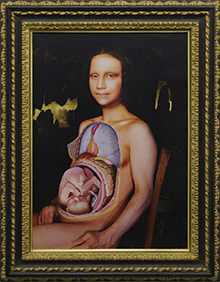 |
|
|
|
Yasumasa Morimura, Mona Lisa in the Third Place (1998), © Yasumasa Morimura, courtesy of ShugoArts. |
The remaining galleries embody the giddy chaos of the anything-goes 2000s, but certain artists stand out for their originality of vision and dedication to craft. Izumi Kato offers two untitled works -- a sculpture and a painting -- of primitive, hypnotically voodoo-like male and female figures. Erina Matsui's ambitious Food Chain Star Wars! vividly depicts a fever dream of natural selection at work, while Manabu Ikeda's History of Rise and Fall is an exquisitely detailed allegory about Japan's political decline. Amid all the surrealism and symbology, Kazumi Nakamura's Scroll Painting 18: Shinran Shonin E-den is a refreshingly abstract study in patterns that betray no obvious connection to the pictorial biography of Shinran, the Buddhist philosopher, referenced by the title.
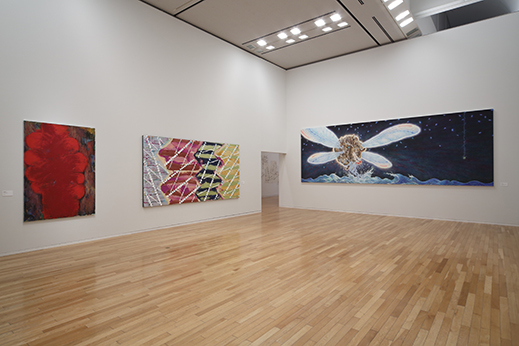 |
|
In the center: Kazumi Nakamura, Scroll Painting 18: Shinran Shonin E-den (2014), © Kazumi Nakamura, courtesy of Kaikai Kiki Gallery. At left: Toeko Tatsuno, Work 89-P-19 (1989), © Toeko Tatsuno. At right: Tomoko Konoike, Chapter 4 "The Return - Sirius Odyssey" (2004), © Tomoko Konoike. Photo by Keizo Kioku |
Appropriately bookending the show are two large sculptures by Yayoi Kusama, effigies of herself and a friendly pooch who greet you as you exit the final gallery. The effect is something like taking leave of an amusement park for contemporary art lovers. We have Dr. Takahashi to thank for providing the many and varied joyrides for the mind within its portals.
Greeting visitors to Mirror Neuron are Yayoi Kusama's Hi, Konnichiwa (Hello)! Yayoi-chan (2004) and Hi, Konnichiwa (Hello)! Pochi (2004). Both works © Yayoi Kusama; courtesy of Kusama Enterprise, Ota Fine Arts. Photo by Keizo Kioku
All images were provided by the Tokyo Opera City Art Gallery. |
 |
|
| |
3F, Tokyo Opera City, 3-20-2 Nishi-Shinjuku, Shinjuku-ku, Tokyo
Phone: 03-5353-0756
Hours: 11 a.m. to 7 p.m. (to 8 p.m. Fridays and Saturdays; entry up to 30 minutes before closing)
Closed Mondays
Access: Directly above the east exit of Hatsudai Station on the Keio New Line, one stop from Shinjuku |
|
|
| |
 |
Alan Gleason
Alan Gleason is a translator, editor and writer based in Tokyo, where he has lived for 30 years. In addition to writing about the Japanese art scene he has edited and translated works on Japanese theater (from kabuki to the avant-garde) and music (both traditional and contemporary). |
|
|
|
|
|
|
|
|
|
 |
|